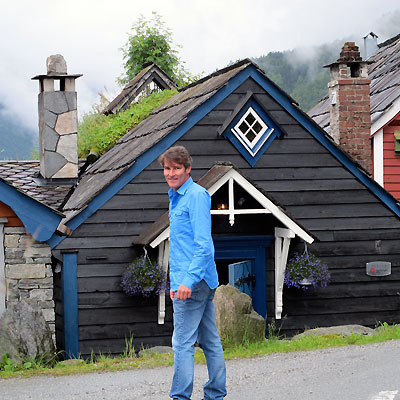
To understand Norway, you need to spend some time outside Oslo. The Norwegians are people who enjoy the outdoors. Outdoor recreation and sports are popular. Skiing, fishing, hiking… But an outdoor life also includes work. Rural life is still a vital part of Norwegian culture. Many people make at least part of their living working on the family farm. From dairy to meat to produce.
That’s because even today there is a very strong farm culture that defines what is traditionally Norwegian. The harsh climate helped shape this tradition. Long dark winters made travel and commerce more difficult than in more temperate zones. Families and communities developed to be quite self-sufficient. That is a core element of what it means to be Norwegian, from this outsider’s perspective.
Being an “outsider”, naturally, I wanted to get outside of Oslo and see some of the countryside that helps shape the Norwegian farm culture. I am glad I did too. The countryside of Norway is breathtaking. Mountains, lakes, rivers, and fjords. Each one grand in scale. Each one touched by God, I believe that.
We stopped in one such place. It’s called Gamlastovo Farm. It’s a working farm, sure. But it also has a 250-year-old restored farmhouse that serves as a small restaurant, bringing food in the traditional Norwegian style. Simple, rugged, and perfectly practical.
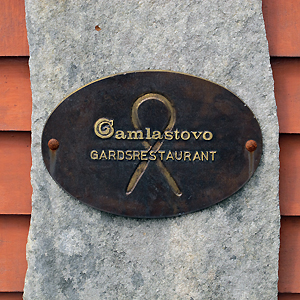 The meal we enjoyed was very much a product of the place we were. Gramlastovo Farm is located very near an area known as Ulvik Hardangerfjord. The Hardangerfjord is Norway’s second-largest fjord. It cuts inward from the ocean a full 111 miles. It defines the area in so many ways.
The meal we enjoyed was very much a product of the place we were. Gramlastovo Farm is located very near an area known as Ulvik Hardangerfjord. The Hardangerfjord is Norway’s second-largest fjord. It cuts inward from the ocean a full 111 miles. It defines the area in so many ways.
It defines transportation. For centuries the only way around a fjord was across a fjord. Hence their proud boating heritage. Farming of animals had to be done seasonally. The only way to get an animal from down here to up there was pulleys. Really.
The sheer power of a protected body of water as large as the Hardangerfjord has a steady effect on the weather. I live beside the Pacific ocean. I know how strong a presence water can have. Bodies like that create a more constant climate. In the Hardangerfjord’s case, it creates a climate that is perfect for 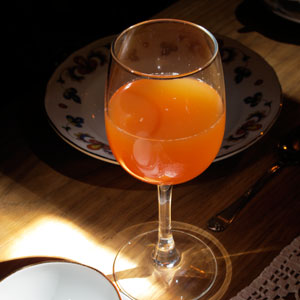 growing cherries and apples. So Ulvik is known as fruit garden of Norway. It has all the beauty of the best gardens you can imagine, plus the bounty of apples and cherries and more.
growing cherries and apples. So Ulvik is known as fruit garden of Norway. It has all the beauty of the best gardens you can imagine, plus the bounty of apples and cherries and more.
On our way to Gramlastovo Farm for our Middag (a late afternoon meal), we stopped at Lekve Farm to see the fruit gardens in full flush. Lekve produces several styles of apple juice and cider. Yep, hard cider too (am I smiling?). In fact, the farm has even begun to produce a quality apple brandy (am I smiling even more??).
Now I like hard cider. You know I do. But what I really want to talk about today is the meal we shared at Gamlastovo. The cottage where meals are served is charming. Picture perfect, fairy tale– cute as button charming. If I did not know better I’d think a set designer was behind the whole damn farm.
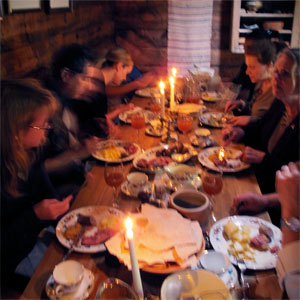 As I stooped to enter the darkened building (the doorways couldn’t have even been 5 feet tall)– I was struck by the sturdy sort of permanence that buildings as old as this maintain. As my eyes grew accustomed to the low light inside, several small rooms outfitted as dining chambers came into focus– tables and chairs in the country Norwegian style. Plenty of shelves and some interesting utilitarian objects spread around the room as decoration. I hesitate to even call them antiques, though they were surely quite old. But the moniker “antique” suggests that these rooms were “decorated” in the “style” of a Norwegian farmhouse. No decorator could ever reproduce the feeling of exactness that permeated these small dining rooms.
As I stooped to enter the darkened building (the doorways couldn’t have even been 5 feet tall)– I was struck by the sturdy sort of permanence that buildings as old as this maintain. As my eyes grew accustomed to the low light inside, several small rooms outfitted as dining chambers came into focus– tables and chairs in the country Norwegian style. Plenty of shelves and some interesting utilitarian objects spread around the room as decoration. I hesitate to even call them antiques, though they were surely quite old. But the moniker “antique” suggests that these rooms were “decorated” in the “style” of a Norwegian farmhouse. No decorator could ever reproduce the feeling of exactness that permeated these small dining rooms.
The tables were set with pretty china, nothing fancy. But appropriately special. There were pitchers of cold Eplesaft (apple juice) set on each table. The kitchen was several (small) buildings 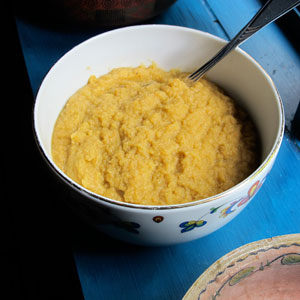 away. But I still caught the whiff of something meaty in the air– I knew we were in for a special meal.
away. But I still caught the whiff of something meaty in the air– I knew we were in for a special meal.
We were served flatbrød (flatbread) and gjetost (brown cheese). There were compotes of local berries too. But this was just something to nibble on as we settled into our places. Now you know me. There are few things as exciting as a new culinary experience. And we were having one.
The first thing I set my eyes upon was a side dish. Rutabaga, baked and mashed. Now I have baked rutabaga before– baked and served as a potato. People like rutabaga, even if they don’t like the name! Maybe I’ll start calling them by their Norwegian name nepestappe. Because these rutabagas were creamy. But without cream. Sure there was plenty of butter, but the creaminess actually came from-hand mixing. I can taste 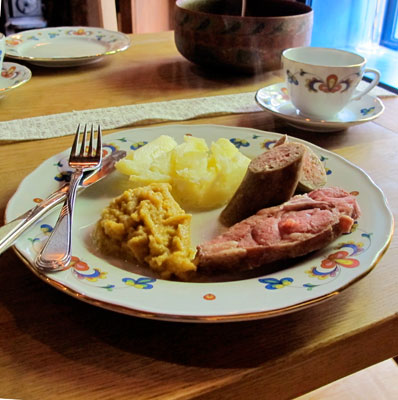 hand-mixing. It tastes like love.
hand-mixing. It tastes like love.
In Noway you might say: “Vårt kjøkken tilberedar maten etter lokaltradisjon, akkurat so gryta hjå ho mor”. Which I think basically means a home-cooked meal just like mother used to make. Which in Norway means boiled potatoes. Simply adorned with butter and parsley. Gamlastova served these alongside a farm sausage (gardskorv) and house-smoked lamb (røykt kjøtt).
Of course something sweet was needed to end this traditional Norwegian country Middag. So after a leisurely walk around the farm, we gathered back around the table for dessert. True to our geography, dessert was made from the excellent local fruit. This time plums. Served as a porridge with vanilla sauce, Plummegrøt, as plummy as you could imagine. Now, where’s that apple brandy?
Norwegian Plum Porridge with Vanilla Sauce
serves 6 CLICK here for a printable recipe
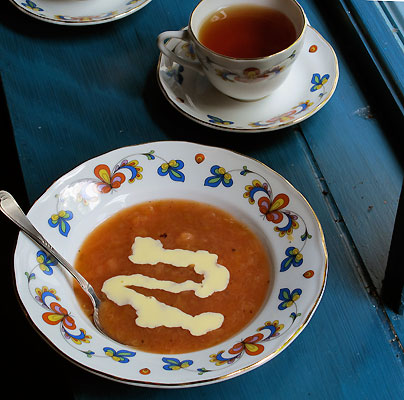 1/2 c butter, cut into chunks
1/2 c butter, cut into chunks- 1/2 c granulated sugar, divided
- 1/2 c light brown sugar, packed
- 1/2 c cream
- 1 T vanilla
- 3 lb ripe plums
- 1/4 c freshly squeezed lemon juice
- 1 c apple juice
- 1 T potato or corn starch
Make the vanilla sauce: Combine butter chunks, 1/2 cup granulated sugar, brown sugar, and cream in a 1‑quart saucepan. Cook over medium heat, stirring occasionally, until mixture thickens and comes to a full boil (5 to 8 minutes). Stir in vanilla. Set aside to come to room temperature.
Make the plum porridge: Chop the plums into small 1/2‑inch pieces, removing the pits as you go. Have a large bowl nearby to collect the plum flesh and any juice that accumulates as you work. Toss the plum pieces with the lemon juice and remaining 4 cups sugar. Add the apple juice and any accumulated plum juice. Let the mixture sit about twenty minutes.
Choose a large, wide heavy-bottomed pot. Add the plum mixture and bring it to a low, slow boil over medium-low heat heat. This could take a half-hour or more. Do not rush it. Stir the mixture frequently scraping the bottom of the pot to make sure the fruit doesn’t stick or burn. Once the low boil is achieved adjust the heat and allow it to simmer an additional 20–25 minutes, skimming off any foam that develops on top. The texture is important, you don’t want to overcook or over stir the fruit to the point that it breaks down too much.
Create a slurry with the potato starch. Turn the heat off and slowly drizzle in the starch, stirring the whole time. Cover the pot and let it sit until it comes to room temperature. The porridge is served at room temperature with a drizzle of vanilla sauce on each portion.
SERIOUS FUN FOOD
Greg Henry
Sippity Sup

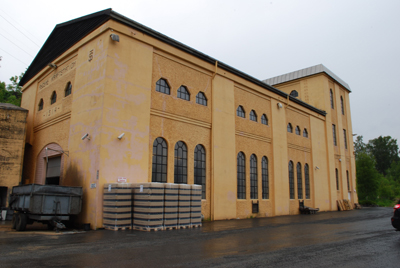

Greg, I am with you on the dry pasta (might be due to DNA influences eheh). I love the chew of good thick-walled rigatoni, they are just the best ever for ragu alla Bolognese (Bolognese sauce) with some bechamel and Parmiggiano 😀 Pity I can’t splurge on them more often sigh 🙁
On the brand side, I do love Voiello for its rich chew and huge rigatoni (paccheri actually).
The only time I feel drawn toward Fresh pasta, aside for the stuffed variety, is for the long shapes like tagliatelle etc, there their elasticity pays off. You won’t find spaghetti in my pantry unless my family has been around lately 😉
Broccoli rabe is one of my favorite veggies. I grew up with it and loved the bitterness. Great recipe, Greg!
I love this post! I had no idea that this was the reason why I prefer some brands over others. I picked up some less common shapes of pasta the other day (at Costco of all places) and the taste was excellent. The brand is Garofalo and the only ingredient listed is 100% organic durum wheat semolina. I’m going to pick up a whole lot more of it before the store by me decides to stop carrying it. Thanks for the info!
We have a great local pasta company; they make a huge selection of pastas that I can not do without. They also have a huge selection of flavored pastas; many with herbs that I also love. But one of my favorites? Sweet potato pasta. Something amazing with butter and brown sugar. I’m spoiled but I also use boxed regular pasta for quick dinners…guess I’m just fussy sometimes!
One of my favorite orders at a little pasta place in midtown…
broccoli rabe — and good imported pasta. The meaty kind. Something to sink my teeth into when it’s cooked just right. This is a great plate of flavors!
and not “Water World.” Gluten-free, the trendiest thing in food since sliced bread. Ha ha!
I’ve made a concentrated effort to find durum wheat pasta ever since you told me how it’s your favorite…and now it’s mine as well. Bring on the gemelli!
My Italian roots are smiling. I prefer to use the word discerning, that is showing good judgement, in your selection of ingredients vs picky. Very informative post Greg.
you’re just steadfast in your preferences!
I have to admit I don’t put much thought into dried pasta and even use Meullers brand. I like Barilla if it’s available but take what I can get.
Greg, broccoli rabe is probably my favourite veggie. And in this dish it automatically elevates it to a great pasta. This would be the type of meal I could eat multiple times a week. Only wish I had some now!
is orecchiette with sausage and broccoli rabe, so I KNOW I’d love this dish with some delightfully decadent guanciale. It’s funny you wrote this post today because I was just talking to my boys about the movie Bull Durham (after seeing Moneyball, and recounting other great baseball movies…The Natural, Field of Dreams etc.) Looks awesome! — S
If you are flawed for being picky about your pasta then I’m with you. I only buy certain brands, too. Love broccoli rabe in simple pasta dishes like this. Wish I could find guanciale–still haven’t been lucky.
100% durum wheat pasta is now my list of things to find/try.
Broccoli rabe is one of my favorite veggies. I grew up with it and loved the bitterness. Great recipe, Greg!
Just mouthwatering…looks so easy to prepare and delicious.
Does anyone else have a hard time finding flour that isn’t enriched? This post makes me want to make my own pasta for drying (I have only made pastas that include egg before), but even most Bob’s Red Mill flours are enriched (and that seems to be the west coast favorite for flours and grains). Advice?
have had no luck in this area… it’s hard. GREG
I’m so heartened to discover someone as particular about pasta as I am!! I don’t think there’s anything wrong with preferring fresh or dried pasta, but I hate it when people think that fresh pasta must, by definition, be better than dried and universally slam dried pasta. Apples and Oranges!! Happy to know I’m not alone… 🙂